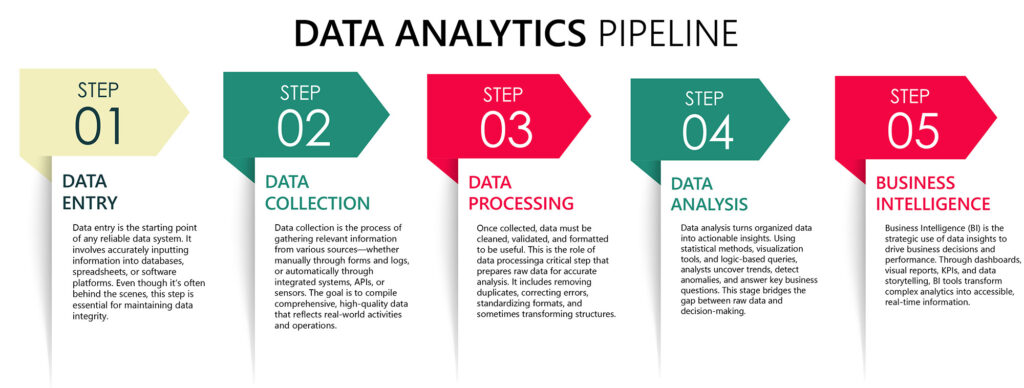
Importance of a Data Entry Associate
In the bustling world of modern business, where decisions are increasingly driven by numbers, trends, and insights, one might assume that the spotlight belongs solely to data scientists and analysts. Yet, behind every polished dashboard, every predictive model, and every business report lies the often-overlooked groundwork laid by Data Entry Associates. These professionals operate at the very foundation of the analytics pipeline, ensuring that data is not only collected but also accurate, organized, and ready for deeper analysis.
While the role may not carry the allure of advanced algorithms or AI-driven forecasts, it is no less essential. Think of it as the root system of a thriving tree hidden from view, yet vital to its health and growth. Without the diligence and precision of data entry specialists, even the most sophisticated analytics frameworks would falter, built on shaky, inconsistent information.
In today’s data-centric environment, where businesses rely on real-time insights to make informed decisions, the contribution of the Data Entry Associate is more relevant than ever. We at AnatoliaDev understand the importance of roles and want to shine light on the critical importance of their work and explore the evolving role they play in shaping the future of business intelligence. Data Entry Associates hold importance and here are the reasons why:
Data Integrity
Data integrity begins with accurate data entry, which serves as the cornerstone for all subsequent analysis and decision-making. When data is entered correctly and consistently, it ensures that the resulting datasets are both reliable and trustworthy. This accuracy is critical because even small errors at the input stage such as incorrect dates, misspelled names, or misplaced decimal points can cascade through a system, leading to flawed analysis and ultimately poor business decisions. In analytics, where conclusions are drawn and strategies are shaped based on data trends, the cost of misinformation can be substantial. Therefore, meticulous data entry isn’t just a clerical task it’s a safeguard against misinformation and a fundamental requirement for maintaining the credibility of any data-driven operation.
Data Preparation
Data preparation is a vital step in the analytics process, and it often begins with the work done by Data Entry Associates. These professionals play a key role in ensuring that information is clean, well-organized, and ready for use in analysis and reporting. By managing initial formatting, validating entries for accuracy, and categorizing data appropriately, they create a structured foundation that analysts can trust. This front-end effort significantly reduces the time analysts would otherwise spend cleaning and reorganizing raw data, allowing them to focus more on deriving insights and making strategic recommendations. In essence, effective data preparation by entry specialists streamlines the entire analytical workflow and enhances the overall efficiency of a business’s data operations.
Speed and Scalability
In large-scale or continuously evolving projects, the ability to manage high volumes of data efficiently is crucial and this is where Data Entry Associates provide significant value. Their proficiency in rapidly and accurately entering information enables businesses to scale their data collection efforts without compromising on quality. Whether it’s processing thousands of customer records, inventory logs, or survey responses, their speed ensures that data pipelines remain uninterrupted and up to date. More importantly, by handling these time-intensive tasks with precision, they free up analytics teams to concentrate on more complex responsibilities such as data modeling, trend analysis, and visualization. This division of labor not only boosts productivity but also ensures that each step of the data process is handled by professionals best suited for the task.
Compliance and Documentation
Data Entry Associates play a critical role in maintaining compliance and supporting strong data governance within organizations. By ensuring that data is captured and recorded according to established regulatory, legal, or internal standards, they help uphold the integrity and auditability of business records. This is especially important in industries with strict compliance requirements such as healthcare, finance, and government where even minor discrepancies can lead to serious legal or operational consequences. Their careful attention to documentation not only ensures consistency and traceability but also provides a clear audit trail that can be referenced for internal reviews or external inspections. In this way, their work forms a vital part of an organization’s risk management and accountability framework.
Bridge to Automation
Data Entry Associates often serve as the frontline observers of repetitive tasks and process patterns within data workflows, making their role a natural gateway to automation initiatives. Through their day-to-day interactions with various systems and formats, they help identify consistent rules and bottlenecks that are ideal candidates for Robotic Process Automation (RPA) or intelligent data capture solutions. By documenting and standardizing these tasks, they lay the groundwork for scalable automation strategies that can improve efficiency and reduce manual effort over time. Rather than being replaced by automation, data entry professionals frequently help drive it providing the insights needed to transition routine tasks into streamlined, tech-driven processes. This evolving role positions them as key contributors in a business’s journey toward digital transformation. Without accurate and timely data entry, the entire analytics pipeline can be compromised. It’s a critical support role that contributes directly to the success and credibility of analytical outcomes.
Having a clear convention whether for data entry, naming structures, formatting, or documentation is not just the best practice in analytics, it’s a necessity. At AnatoliaDev, we’ve seen firsthand the consequences of neglecting these standards. In one case, a client refused to adopt any consistent conventions, despite repeated recommendations. The result was a chaotic data environment where duplication, inconsistency, and gaps made meaningful analysis nearly impossible. Worse, critical business decisions were made based on this flawed data, leading to long-term impacts that still affect the organization today. Ultimately, the lack of convention left no viable path to clean recovery forcing the client to cover up the issue rather than address it transparently. This experience underscores a hard truth that without discipline and consistency in how data is managed, even the most advanced analytics tools and talent can’t deliver reliable insight and here is why:
Consistency
Consistency is the backbone of reliable data management, and it starts with having a clear, enforced convention. When everyone involved in data entry and analysis follows the same standards for naming, formatting, and categorization, it ensures that data is entered and interpreted uniformly across individuals, teams, and systems. This uniformity eliminates ambiguity, reduces errors, and makes it easier to merge, compare, and analyze data from different sources. Without consistency, even simple tasks like filtering or aggregating data can become problematic, leading to misinterpretation and flawed insights. A well-defined convention is not only streamlining collaboration but also supports automation and system integration, making data more actionable and trustworthy at every level of the organization. It minimizes errors, especially in large teams or long-term projects.
Scalability
Scalability in data management hinges on the presence of consistent conventions. As datasets grow and projects expand, maintaining order becomes increasingly challenging unless a clear structure is in place. Consistent naming, formatting, and documentation practices allow data and code to scale seamlessly without becoming chaotic or error prone. When conventions are followed, it’s easier to onboard new team members, integrate new systems, and build upon existing work without confusion or rework. At AnatoliaDev, we’ve observed that teams with strong foundational standards can scale their analytics capabilities far more effectively, whereas those without them often hit a wall burdened by inconsistencies that require constant cleanup. In short, good conventions aren’t just about neatness, they’re about enabling sustainable growth.
Efficiency
Efficiency in analytics depends heavily on how well data is structured and standardized from the outset. When consistent conventions are in place, analysts and developers can spend less time untangling messy datasets or decoding inconsistent scripts, and more time generating insights and building impactful solutions. Tools like Power BI and Excel both of which are central to many of our projects at AnatoliaDev rely on structured, predictable inputs to perform optimally. Standardized column names, uniform data types, and consistent formatting allow these tools to refresh, link, and visualize data more smoothly, reducing the likelihood of errors or broken reports. In environments where time is money, strong conventions translate directly into faster turnaround, lower costs, and more reliable outcomes.
Collaboration
Effective collaboration in data projects is only possible when there’s a shared understanding of how information is structured and managed and that begins with strong conventions. When consistent naming, formatting, and documentation standards are followed, team members can quickly understand each other’s work, dramatically reducing onboarding time and making reviews more efficient. This clarity fosters smoother handoffs between teams and ensures that projects remain accessible, even if the original creator is unavailable. At AnatoliaDev, we’ve seen how the absence of conventions can trap knowledge within a single person’s head, creating bottlenecks and risking project continuity. In contrast, a convention-driven environment encourages knowledge sharing and builds team resilience by making processes transparent, repeatable, and easy to maintain.
Automation
Automation thrives on predictability and that’s exactly what conventions provide. Whether you’re working with scripts, formulas, queries, or automated workflows, having standardized data structures and naming conventions is essential for things to run smoothly. Automation tools are not intuitive they rely on precise instructions and consistent input formats to execute tasks correctly. Without conventions, even the most well-designed script can break or produce inaccurate results, leading to delays and rework. At AnatoliaDev, we frequently design automated solutions in Excel, Power BI, and other platforms, and we’ve learned that success hinges on predictable patterns. Well-established conventions are the foundation that makes automation not only possible, but reliable, scalable, and efficient.
The First Steps Towards Order
- File and folder naming
- Column headers and data formats
- Date/time formatting
- Use of codes vs full text (e.g., “CA” vs “California”)
- Naming in Power BI models (measures, tables, relationships)
In short, conventions are like a shared language they make the whole analytics process cleaner, faster, and far more reliable. Naming conventions proved to be such a critical and often overlooked topic in our work at AnatoliaDev that we’ve decided to dedicate our next news update entirely to it. From preventing confusion to enabling seamless automation, naming standards deserves spotlights of their own. Stay tuned, we’ll be diving deeper into how thoughtful naming can transform your data strategy.
In the world of data, structure is everything. Whether it’s ensuring accuracy at the point of entry or enabling sophisticated automation, conventions are the invisible framework that supports every layer of the analytics process. At AnatoliaDev, we’ve seen how organizations that neglect these fundamentals often struggle with unreliable insights, inefficient workflows, and long-term operational setbacks. On the other hand, those that prioritize clear standards for data entry, formatting, documentation, and collaboration position themselves for scalable, high-quality analytics that truly drives business value. Conventions aren’t just a formality they’re a strategic investment in the integrity, efficiency, and future-readiness of your data systems. By committing to these best practices early, businesses can build a foundation strong enough to support any level of growth or innovation.
